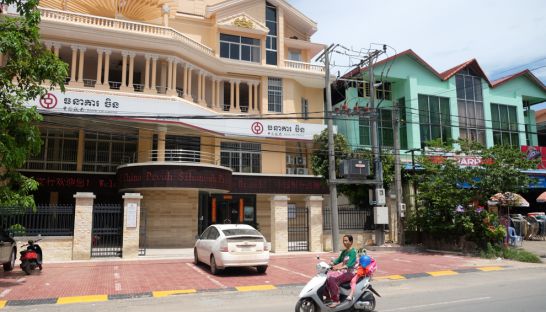China’s squeeze on capital outflow felt in Cambodia
China’s squeeze on capital outflow felt in Cambodia
Stringent capital controls imposed by China’s central bank last November that scrutinise the outbound flow of money from the mainland have created uncertainty for Chinese investors looking at the Cambodian market and could jeopardise future and existing projects.

The Chinese government has imposed restrictions on any business that tries to move $5 million out of the country, or $50,000 per year in the case of an individual, including overseas investments, money transfers and foreign exchange purchases. The measures are intended to stem capital flight, shore up reserves and prop up the value of the renminbi currency in the face of the Asian giant’s economic slowdown.
Mainland Chinese investors looking into overseas ventures have criticised the capital controls, claiming they are onerous and have already resulted in the cancellation of overseas investment projects, mergers and acquisitions.
Meanwhile, legal analysts have indicated that Beijing’s sweeping restrictions and vaguely worded statements on outbound capital flows were putting a damper on Chinese investor sentiment and would likely have repercussions in all investment destinations, including Cambodia.
“The recent capital controls, in particular the extent to which such controls will extend, have created uncertainty among Chinese investors and their overseas counterparts alike,” said Robin Teow, a senior consultant at DFDL Cambodia and co-head of the law firm’s China desk.
“In China, the specifics of policies and official guidance, if any, are usually broadly worded and Chinese authorities have wide discretion in implementing policy goals on a case-by-case basis.”
As a result, he said Chinese investors are facing delays in both securing finance for overseas ventures and receiving regulatory clearance from Chinese authorities, which has resulted in the demise of numerous business deals.
“The number of scrapped deals is also bound to increase due to Chinese investors’ failure to get the money to pay for a deal out of China or the increasing wariness of foreign parties to engage in any serious business discussions with Chinese parties as a consequence of the uncertainty about the Chinese government’s reaction to a specific deal,” Teow said.
He added that figures from the Chinese Ministry of Commerce show how harshly the capital controls have impacted outbound investment.
During the first quarter of 2017, outflows of foreign direct investment dropped by nearly 49 percent year-on-year to $20.5 billion.
“As a result, we are definitely witnessing a drop in Chinese cross-border purchasing trends due to tighter capital controls,” he said. “[However] we still receive a great deal of enquiries from Chinese investors about potential investments in Cambodia, even though some of these may take a while to gain traction.”
The potential impact on Cambodia could be substantial. China is the largest single investor in Cambodia, accounting for about 44 percent of the $19.2 billion in FDI pumped into the Kingdom between 1994 and 2014, according to government data.
While there is no official tally of quarterly private sector investment from China for comparisons, Cambodia may have already had its first casualty, with a Hong Kong-listed real estate developer claiming in March that Beijing’s capital controls were blocking its progress on a hotel project in the Kingdom.
Zhang Li, founder and co-chairman of Guangzhou R&F Properties, which previously announced plans to invest $3 billion into a luxury hotel in Cambodia, told a Chinese daily newspaper that the “current capital controls are too tight” and had brought progress on the project to a standstill.
Jiajia Xing, a senior director of Cambodian law firm Sok Xing and Hwang, said there was no doubt that the restrictions have hobbled some Chinese-backed projects in the Kingdom.
“Yes, they are [hindered],” she said, adding that she could not disclose specific businesses that have been affected due to legally binding confidentiality agreements.
However, she said some of these Chinese investments were overzealous to begin with.
“In my view, these projects needed to conduct more careful project planning and feasibility studies before they kicked off,” she said.
While Xing emphasised that investment from China to Cambodia continued to flow, she said the Chinese government was trying to ensure that “outbound investment is made in a healthy and orderly manner”.
“The relevant laws and regulations have been more carefully and strictly enforced by Chinese regulators than before,” she added.
Despite the crackdown on outbound investments, Joseph Lovell, a partner at the regional law firm Sciaroni and Associates, said Cambodia could buck the trend given its geopolitical importance to Beijing and its favoured status under China’s One Belt, One Road policy.
“In general, smaller markets would be expected to feel the pinch more,” he said. “However, as investment in Cambodia is currently favoured by Beijing, including the One Belt, One Road policy and the focus on Cambodia and Laos as influence centres within Asean, Chinese investors may find it easier to get approval for investments here over say Brazil or Sweden.”
In addition, Lovell said there were easy legal ways for Chinese investors to circumvent the scrutiny of Chinese capital control authorities.
“The easiest legal way to work around the controls are to deploy capital that is already outside of China,” said Lovell, adding that Chinese multinationals can generally move offshore investment capital without requiring the approval of the Beijing-based State Administration for Foreign Exchange (SAFE).
Meanwhile, Teow also said that there had been increased utilisation of a mechanism that allows assets pledged by a Chinese borrower’s onshore affiliates to be used in lieu of an offshore guarantee in order to refinance its offshore debt.
Nevertheless, both legal advisers warned that Chinese investors looking into Cambodia should be prepared to face continued scrutiny regardless of whether or not an investment was in line with the One Belt, One Road policy, with Lovell adding that “the policy is somewhat fluid so the ease of obtaining approval from SAFE can vary based on the prevailing [political current]”.














